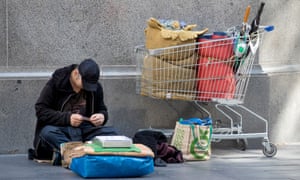Extract from The Guardian
Almost 300,000 people sought help from a homelessness agency in past year, with over 55s the fastest growing cohort, new report shows
Some 260 people were turned away from homelessness services every day in 2019-20, usually because there was nowhere for them to stay, a new report says.
And at the height of the Covid-19 crisis, about 6,000 people a month were forced to seek or receive homelessness services due to the pandemic.
An Australian Institute of Health and Welfare (AIHW) report, released on Friday, examined demand for homelessness services in the 12 months to 30 June.
It found 290,500 clients had sought help from a homelessness agency, up from 279,200 in 2015–16, but steady compared to the 2018-19 financial year.
The report said 114,000 of those people were homeless when they sought help, while 152,300 were at risk of homelessness.
Across 2019-20, there were 95,300 requests for homelessness support that went unmet, equal to 260 a day, and 3,000 more than the previous financial year.
Of those requests, 60% were for people seeking short-term or emergency accommodation, and calls for help were generally denied because there was no accommodation available at the time, the report said.
People were most likely to be turned away from services in Victoria, followed by Western Australia and Tasmania.
Jenny Smith, the chair of Homelessness Australia, said the data showed that more than two-thirds of those turned away from services were women or girls.
“This includes many women who were presenting to homelessness services with young children,” she said.
“There were 11,201 children under 10 who missed out on support this year.
“The number of people that homelessness services have to turn away has continued to grow each year. It’s clear that there is a growing gap between the demand for support and the resources available to homelessness services.”
In March and April, the pandemic prompted action among state and territory governments concerned that rough sleeping could jeopardise the health response.
Governments boosted funding and offered hotel rooms to rough sleepers, while the federal government doubled some welfare benefits from April to September.
The AIHW report only covers the first three months of the pandemic, but in New South Wales for example, 3,000 people sleeping rough were provided with temporary accommodation during the crisis, while 2,600 people experiencing homeless were provided accomodation in Victoria.
The same was true for 300 people sleeping rough on or in shelters in Queensland.
Separate monthly data compiled by the AIHW reveals there were 6,144 homelessness clients who cited Covid-19 as their reason for seeking help in September.
Of those, 4,418 were in Victoria, compared to 806 in Queensland and 586 in NSW.
In Victoria, in particular, “demand for emergency accommodation “increased notably since March 2020”, the report said.
Smith said that while the states had increased funding during the pandemic, the federal government had declined to offer more specific support for homelessness services.
Critics have also argued that in some cases, and particularly at the height of the pandemic, some rough sleepers were still left by state governments to languish on the street, or made to pay to stay in lockdown hotel accommodation.
Who is seeking help?
The report, an annual snapshot that has run since 2011, provides an insight into who is seeking homelessness services in Australia.
It finds that 60% or almost 174,700 clients were women in 2019-20, while 29% or around 85,000 were under 18.
There were 24,400 people aged 55 years or older seeking homelessness services, the fastest-growing cohort, the report said.
Aboriginal and Torres Strait Islander people were vastly over-represented in the statistics, making up about 3% of the Australian population but more than one-quarter of all homelessness clients (27% or almost 71,600).
Smith, who is based in Victoria, said demand in her state among Indigenous clients was growing at twice the rate as the general population.
In general, the highest demand per population was in a section of Western Australia that covers Broome, Exmouth, Geraldton, Kununurra and Port Hedland, where there were 583.1 clients per 10,000 people.
In the Northern Territory, excluding Darwin, there were 575.9 client per 10,000 people.
Gabrielle Phillips, an AIHW spokesperson, said people who live with mental health issues were also one of the “fastest growing client groups”.
The cohort had increased by 22% since 2015-16 and made up almost a third of all clients in 2019-20.
Phillips said factors including reduced stigma may have increased identification among people seeking help.
The report also found 38% – almost 91,700 clients – presented to a homeless agency while experiencing family and domestic violence, while 12% reported problematic drug and or alcohol use.
Other notable cohorts included the 6,400 NDIS participants who sought help in 2019-20, and the 1,400 clients who self-identified as a defence force veterans.
Guardian Australia reported this month that some people in Victoria who had been provided hotel accommodation during the pandemic were now being exited from the program.

No comments:
Post a Comment